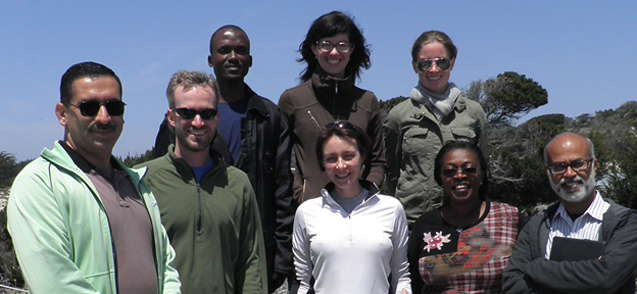
The Housner Fellows at their leadership training week in Asilomar, California, in June 2012. Top row, from left: Hassan Mdala, Danielle Mieler, Lindsey Maclise; Bottom row, from left: Syed Ali, Cale Ash, Kate Stillwell, Carlien Bou-Chedid, Vivek Rawal.
In 2012 the Earthquake Engineering Research Institute (EERI) created the Leadership Training Program with funding from George Housner, one of the fathers of earthquake engineering, GFDRR and the United States’ Federal Emergency Management Agency (FEMA). The mission of the Housner Fellows Program is to train the next generation of earthquake seismic safety and advocacy leaders. The program selects a cohort of early to mid-career professionals and includes a one-week intensive leadership-focused course, ongoing professional development training, participation in the EERI Annual Meeting, assistance with network building, and two years of one-to-one mentoring from senior seismic safety professionals. Fellows are required to develop and complete individual projects as well as a group project, where they have the opportunity to hone their leadership and advocacy skills.
The inaugural class of 2012 currently has eight fellows. Three of the eight fellows are supported by funding from GFDRR: Syed Ali, Director, Earthquake Engineering Centre, University of Engineering & Technology, Peshawar, Pakistan; Carlien Bou-Chedid, Structural Engineer, Ghana Institution of Engineers on the Geological Technical Committee of NADMO; and Hassan Mdala, Geologist, Geological Survey Department of Malawi. Each fellow has an individual project and participates in the group project with the other fellows.
The Fellows’ Individual Projects
Below are a brief overview of the individual projects of the GFDRR-supported fellows:
Preparing Malawi for the Next Earthquake

Hassan Mdala will develop a series of Earthquake Safety Posters (an Indonesian example here) in English and his local language. These posters build on Earthquake Safety Guidelines, recently prepared by the Malawi Geological Survey Department, that are being distributed to responsible governmental departments and non-governmental organizations. Most people in Malawi know nothing about earthquake safety issues, so by presenting basic information in pictorial form, Hassan’s project will begin to increase awareness of the earthquake risk in his country.
Building Safer Homes for Families in Ghana

Carlien Bou-Chedid will introduce confined masonry construction for use in Ghana. While commonly built in some Latin American and Asian countries, it is not typically found in Africa. Confined masonry is a technology that, if built correctly, performs very well in earthquakes. It uses the same basic materials of concrete and brick that are found in unreinforced masonry construction and in reinforced concrete frame construction with masonry infills, but with a different construction sequence and system. In confined masonry construction, the masonry walls carry the seismic loads and the concrete is used to confine the walls. The goal is to reach all who may be involved in the construction of homes and educate them on the use of confined masonry construction to build for earthquakes. Targeted groups are potential homeowners, artisans, technicians and building professionals. An Illustrated Guide for Ghana will be prepared by adapting information contained in existing documents on confined masonry construction. A 15 minute documentary and training film will also be prepared on confined masonry construction.
Increasing Awareness of Risk and Mitigation Strategies Associated with Concrete Frame Buildings in Pakistan

Syed Ali is working on a component of EERI’s Concrete Coalition Project. This project is addressing the earthquake risk associated with older reinforced concrete (RC) frame buildings, a prevalent construction type in the U.S. prior to development of codes for ductile reinforced concrete, and still commonly built in many developing countries, including Pakistan. RC frame buildings with infill have a history of poor seismic performance, and many have collapsed in past earthquakes, leading to significant loss of life. In his individual project Ali will: (a) guide the Peshawar EERI student chapter in contributing field data from reinforced concrete frame buildings that were damaged during the major 2005 Pakistan earthquake; and (b) meet with various regional stakeholders to identify policy and implementation issues that contribute to the continued construction of poorly detailed, brittle concrete buildings. The outcome of his project is twofold: information on the performance of concrete buildings in the 2005 earthquake will be added to the database on damaged concrete buildings that is under construction at EERI, helping a global community of researchers and practitioners understand critical failure mechanisms; and recommendations to policymakers and other stakeholders will be made on changes to codes or practice that can improve the seismic performance of these buildings.
To learn about all the individual projects, visit http://www.eeri.org/projects/housner-fellows-program/housner-fellows-program-projects/.
The Fellows’ Group Project and Next Steps
After going through a careful process of evaluation and discussion, the eight fellows recently decided on their group project: Earthquake Safe School Construction: Case Study in Ghana. The project is going to focus on new school construction in Ghana and will create and distribute seismic design guidelines to the consultants and government agencies that are managing a new school building program. Ghana is undergoing rapid growth as a result of oil exploration and extraction, and anticipates building 200 new schools in the coming few years. The fellows will work collaboratively with the consultants as well as stakeholder groups. Carlien Bou-Chedid, the Housner Fellow from Ghana, will be the liaison between the fellows and the local stakeholders and consultants. The expectation is that seismic design guidelines and construction documents developed for Ghana can also be adapted by other developing countries. The fellows, all volunteer their time for the leadership program, which includes time for this project as well as their individual projects. GFDRR and EERI funding support will be used to bring the fellows together for a meeting in Ghana in late 2013.
Example of safe school versus unsafe school:
Content and images courtesy of the Housner and GFDRR teams. For more information, please contact Christina Irene at cirene@worldbank.org.
